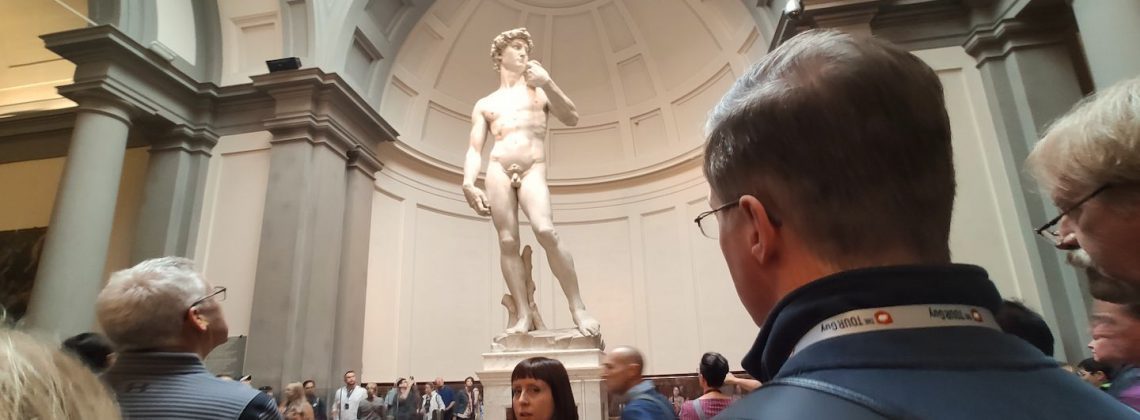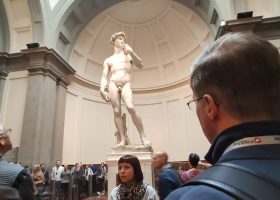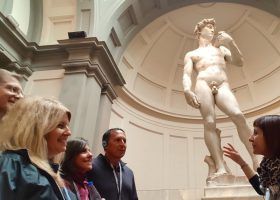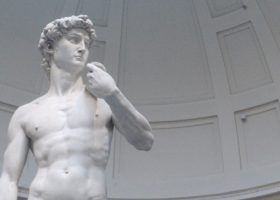Around 1.5 million people visit this tiny museum each year to see Michelangelo’s David. Standing 17 feet tall, it’s not hard to understand why everyone wants to see this statue. However, that means long lines, crowds, and congestion—unless you plan ahead. In this guide, we share everything you need to know about visiting the Accademia to see Michelangelo’s David.
Pro Tip: Planning your visit to the Accademia in Florence? Bookmark this post in your browser so you can easily find it when you need it. Check out our Accademia Gallery Guide for more resources, our best Accademia and David tours for a memorable trip, and how to see Florence in a day (with itinerary).
Visiting the Accademia and David: What We’ll Cover
The Accademia Gallery is a small museum with a very big attraction—Michelangelo’s David statue. It receives around 1.7 million visitors every year. In this guide, find out everything you need to know about visiting the Accademia from tickets to tours and the top things to see at the gallery besides David. Here’s what we’ll cover:
- Opening hours and tickets
- How much time to budget for your visit
- How to get there
- What to see at the Accademia
- Guided tour options
- Where to eat nearby
Not ready to book a tour? See our best Florence tours to take and why.
Accademia Gallery Opening Hours and Tickets
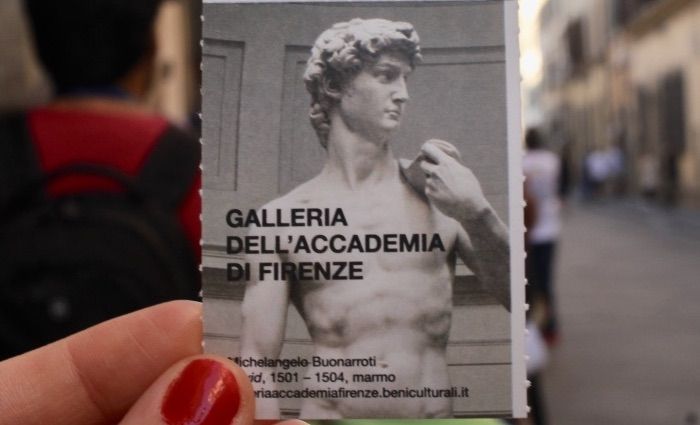
The Accademia Gallery in Florence maintains practically the same hours as all major museums in Florence. Closed on Mondays and open from 9 am to 6:45 pm daily. The ticket office closes 30 minutes before closing each day. A maximum of 200 visitors are allowed inside at a time, which keeps this very small gallery quite pleasant to visit.
The most important step to seeing Michelangelo’s statue of David in Florence is getting tickets for the Accademia Gallery in advance. The key phrase is “in advance” as there are long lines. As always, we recommend you take a tour including Accademia. Tours add to your experience and we run small group tours which vastly improve the experience.
Opening hours:
Open Tuesday to Sunday, 8:15 am to 6:50 pm (last admission at 6:20 pm). Closed Mondays, January 1, and December 25. Check the official website for seasonal variations in hours.
Tickets:
- Regular tickets cost €12 per adult
- Reduced tickets for EU citizens 18-25 cost €2
- Under-18s enter the gallery for free
Restrictions:
- Water bottles over 0.51ml (anything larger than a standard bottle)
- Helmets
- Large bags or backpacks
Address: Via Ricasoli, 58/60
How Long To Spend at the Accademia Gallery
Short Answer: 60 minutes
I know 1 hour may not sound like a lot, but it is sufficient to see the best of the Accademia Gallery. If you go to the Accademia’s official website, they have a list of just five things they consider “must-see” in the gallery. Even their website basically says that it’s really all about David, and I get it. The statue of David may be the greatest sculpture ever presented by humanity.
Twenty minutes should be used exclusively for David. Ten minutes will go to getting in and out of the building. The next 30 minutes should be for seeing the works of art in our section on what to see at Accademia.
There are definitely a few other great pieces of artwork in Accademia, but my favorite section is the musical instruments. Did you know the Piano was invented in Florence for the Medici?
Not ready to book a tour? Check out the best Florence tours to take and why.
How To Get To the Accademia Gallery
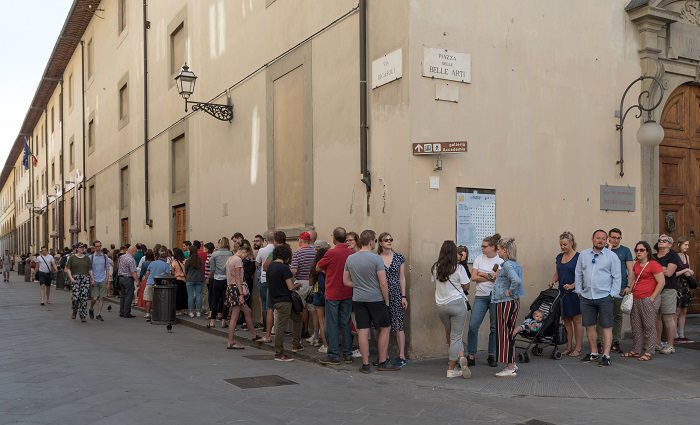
There is no massive piazza (square) framing the Accademia. You’ll find it on a small side street with very little vehicle traffic. You’ll know you are in the right place when you start to see long tall signs with the statue of David on them hanging on the side of an unassuming Renaissance building. The signs simply read: “GALLERIA DELLA ACCADEMIA.”
The gallery is centrally located in Florence and easily accessible on foot from anywhere in the center. Here are the walking times from various other attractions in Florence:
- 15-minute walk from Santa Maria Novella Train Station
- 8-minute from Santa Maria del Fiore (Il Duomo)
- 15-minute walk from Uffizi Gallery and Ponte Vecchio
- 30-minute walk from Piazzale Michelangelo
Address: Via Ricasoli 58/60
What To See at the Accademia Gallery
I’ve seen a great tour guide turn a clay pot into one of the most interesting things I’ve ever seen before. Passion and knowledge are what really make or break a tour. So, while the Accademia is a small gallery, there are enough great stories behind the artwork to make it come alive.
Here’s a list of the must-see works at the Accademia Gallery. For a more in-depth list and longer descriptions, see our dedicated article on the top things to see at the Accademia in Florence.
David aka The Tribune
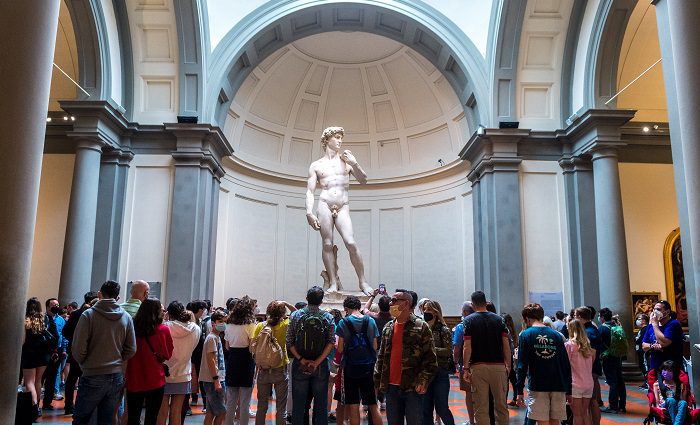
David is the main attraction of the gallery and without doubt the most visited sculpture in Florence. Michelangelo “freed” David from his marble “prison” in three years. The statue of David is 17 feet tall and modeled after the old-testament figure who defeated Goliath at the Valley of Elah when the Israelites (David) fought the Philistines (Goliath). The statue is considered Michelangelo’s masterpiece, at least in terms of sculpture.
Museum/Hall of Musical Instruments
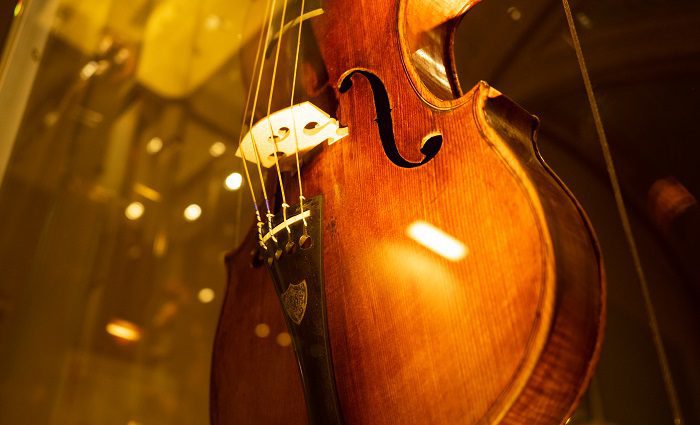
Did you play the violin growing up? Well, the Hall of Musical Instruments in the Accademia may be a nice stop beyond the David statue. In the 17th century, there lived a man by the name of Antonio Stradivari who produced unmatched musical instruments for centuries.
Mechanical honing of instruments has eventually led to better sound projection, but Stradivarius instruments were the finest instruments for over 200 years. That’s enough time to earn a serious following. Today, a Stradivarius viola has sold for $16 million dollars.
The Museum of Musical Instruments contains multiple Stradivarius including a viola tenor and a cello from the Medicean collection of instruments—their coat of arms decorate both instruments.
The viola is reportedly unchanged from the day it was first played. You’ll also find a room dedicated to the invention of the piano, which was invented for the Medici in 1720.
Florentine Gothic Art
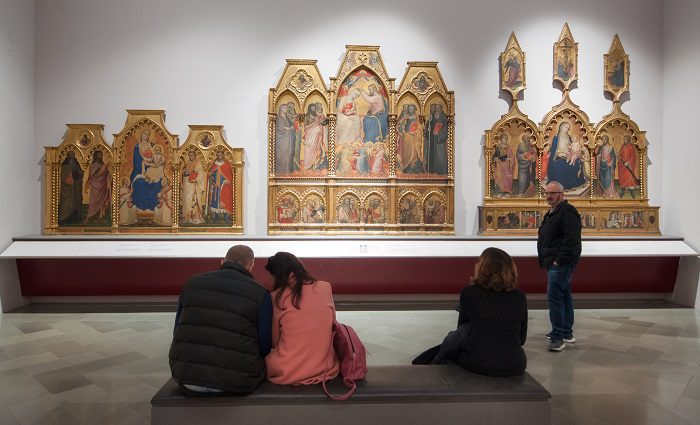
This room, dedicated to the 13th and 14th centuries, houses many Gothic altarpieces adorned with gold. As a lover of Renaissance art, I don’t value Gothic art as much as I should.
That said, the room deserves a walk-through. Keep an eye out for Bonaguida’s Tree of Life panel showing Christ on the crucifix, which doubles as the tree of life.
Gipsoteca Bartolini
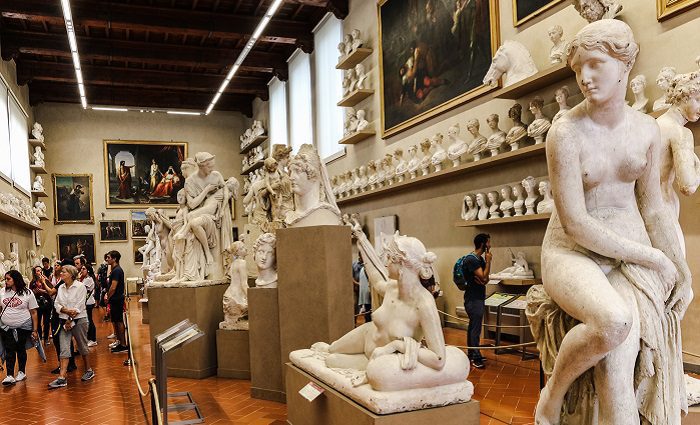
While there is no real artistic significance in this room, it is pretty cool when you understand what you are looking at. Obviously, you couldn’t have your photo taken in the Renaissance, which makes it difficult to leave a legacy. So, being painted or ideally carved from stone was your only hope for a legacy.
The Gipsoteca is a virtual yearbook of anyone who was important in the 19th century. Noble Russians, Brits, Pols, and anyone else with enough money to have a bust made is in this room.
Hall of Prisoners
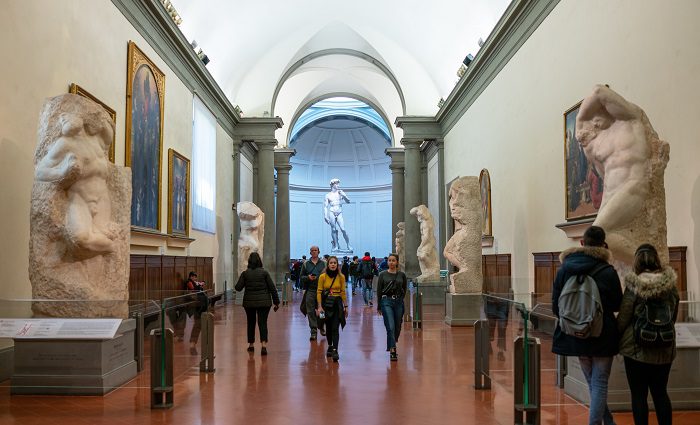
Leading up to David is the Hall of Prisoners. Michelangelo was quite the artist and took his craft very seriously. You don’t labor over a statue for three years without passion. As you may have read, he didn’t feel he was the creator of this artwork. He felt more like a liberator and technically he’s correct.
To him, the statues already existed in the block of marble, he simply freed them. The hallway leading to his masterpiece is lined with his failures—unfinished statues that didn’t make it out.
Referring to these statues as prisoners is both literal and figurative. They are trapped in marble but they were actually intended to be statues of prisoners holding up columns for the tomb of Pope Julius II.
Hall of Colossus
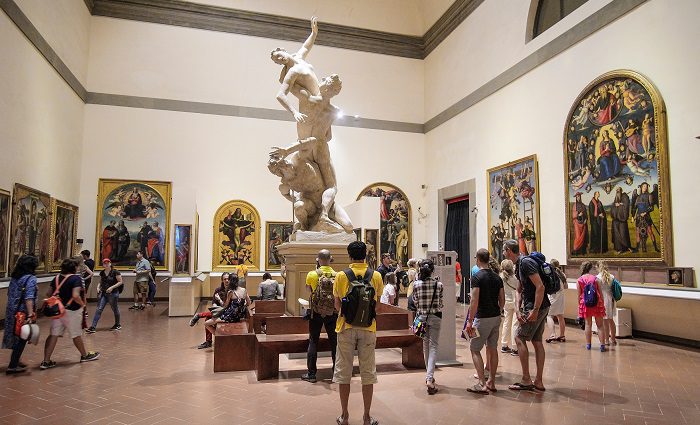
The Hall of Colossus is the most significant collection of relevant artwork in the Accademia not including David. The centerpiece is Giambologna’s Rape of the Sabines. A heavily used and incredibly significant historical scene from Antiquity, it is a wonderful baroque statue ripe with passion.
You’ll also find works of art in this room from Botticelli, Ghirlandaio, Perugino, Filippino Lippi, and others. They were a tight-knit group of artists that often worked together—the first three created works inside the Sistine Chapel of Rome.
Accademia Gallery Tour Options
Doing a tour of the Accademia is by far the best way to see Michelangelo’s David and our tours include much more than that. Here are our best guided tours with skip-the-line Accademia Gallery tickets and an expert guide to bring the art and space to life:
Florence Walking Tour with Statue of David (3 hours)
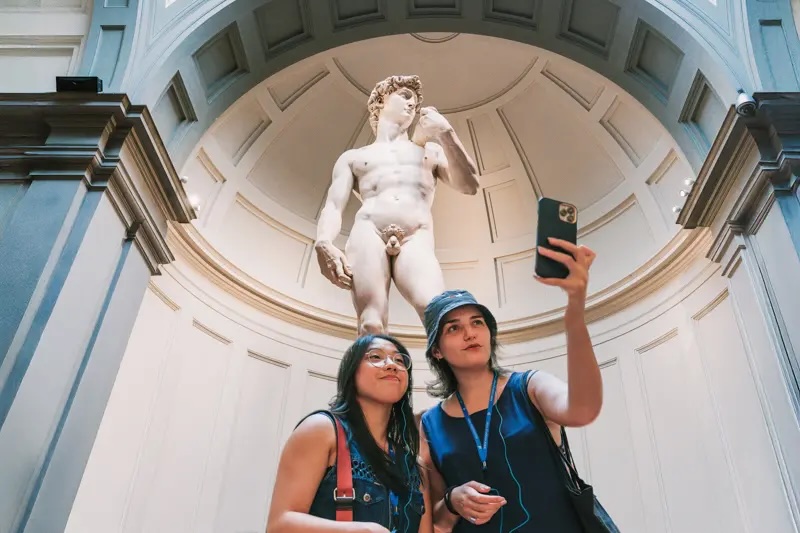
This is our most popular tour in Florence. It includes skip-the-line admission to see David and the Accademia for a guided visit. Your English-speaking guide will then take you to see the Duomo and Santa Maria del Fiore from the outside.
You’ll also see the Baptistry Doors, Piazza della Signoria, Ponte Vecchio, Dante’s District, the Bronze Boar, Leather Market, and Orsanmichele Church. There is always time for a gelato stop too!
See tour itinerary, price, and description
Florence in a Day Combo Tour With David and Uffizi (6.5 hours)
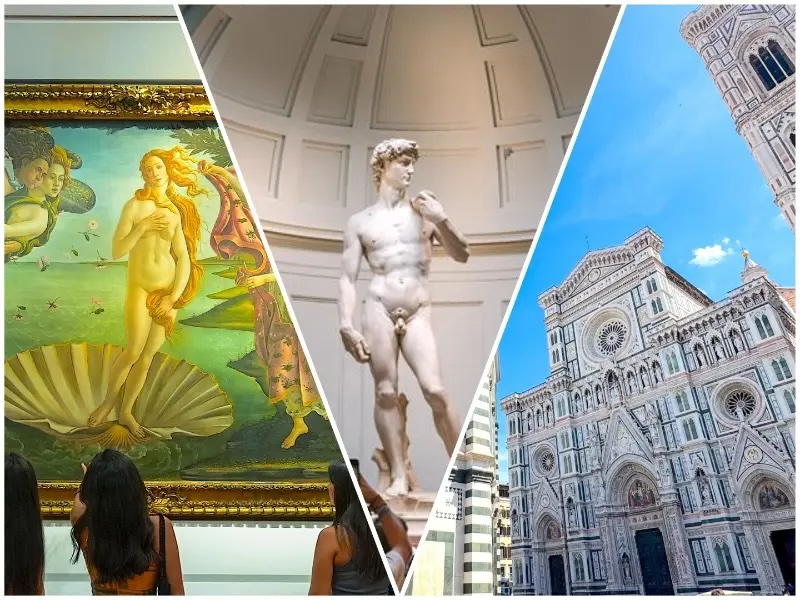
Make the most of your trip to Florence by getting to know the most beloved sites in a single day. With skip-the-line tickets and a fun, local guide, you can breeze through the Accademia and Uffizi galleries, see the Florence Duomo, and get to know the famous Ponte Vecchio.
You’ll also enjoy stops at the neighborhood where Dante grew up and learn about the Medici family who shaped Florence into the city we know today.
See tour itinerary, price, and description
Florence Private Walking Tour with Michelangelo’s David (3 hours)
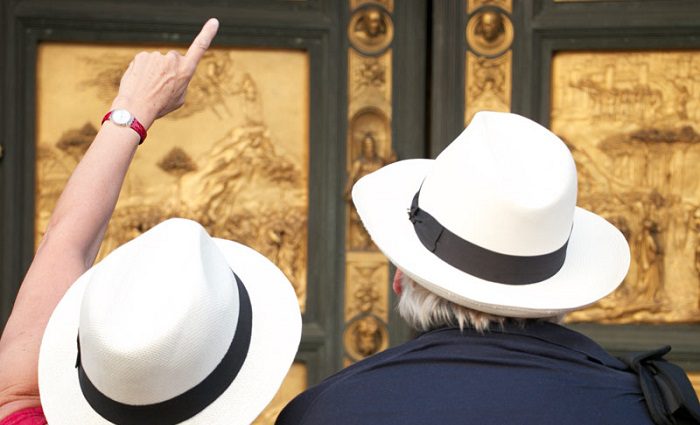
For those who prefer an experience tailored to their needs or interests, a private walking tour of Florence and Accademia Gallery is just the thing.
Enjoy a more engaging time with a guide who is focused on you and your interests. You’ll explore Accademia Gallery, the Florence Duomo, Ponte Vecchio, and much more on this private tour of Florence.
See tour itinerary, price, and description
Statue of David Evening Tour (1.5 hours)
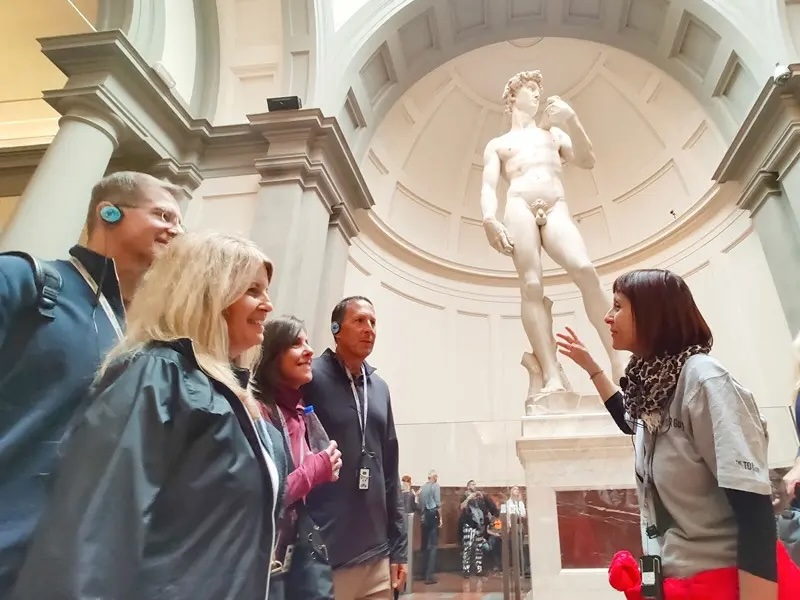
If you’re just looking for a quick, guided tour of Accademia Gallery to see Michelangelo’s famous David statue without the crowds, book this one! Since this tour starts in the evening, you’ll appreciate that there are fewer crowds.
Not to mention, an hour and a half is the perfect amount of time to spend with a passionate guide who will make sure you know cool stories about the art found in this gallery. (And why David’s feet are rather oversized!)
See tour itinerary, price, and description
Accademia’s David and Uffizi Skip the Line Tour
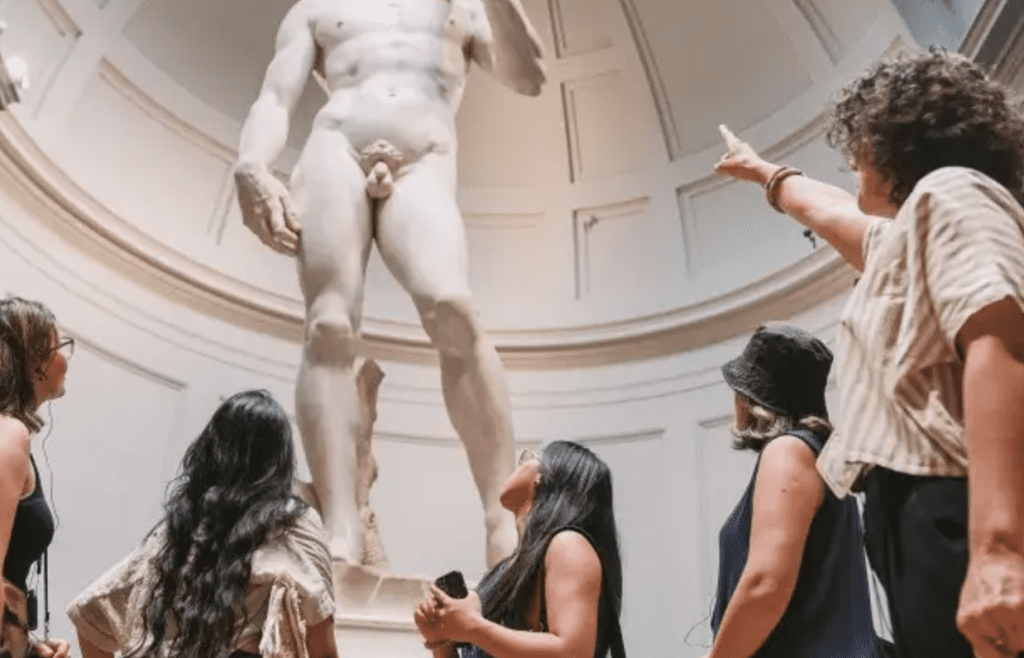
After meeting your friendly guide in Piazza Santissima Annunziata, you’ll quickly head off to discover Florence’s most celebrated works of art in one efficient tour. Perfect for those who want to experience the highlights of the Renaissance without feeling rushed, this combo tour takes you to the Accademia Gallery and the Uffizi Gallery, showcasing the finest treasures of Florence in just a few hours.
Once the guided tour is over, you’ll finish inside the Uffizi Gallery at Caffe Bartolini, where you can enjoy an espresso on the terrace with spectacular views of Brunelleschi’s Dome!
See tour itinerary, price, and description
Florence Accademia Gallery Express Guided Tour
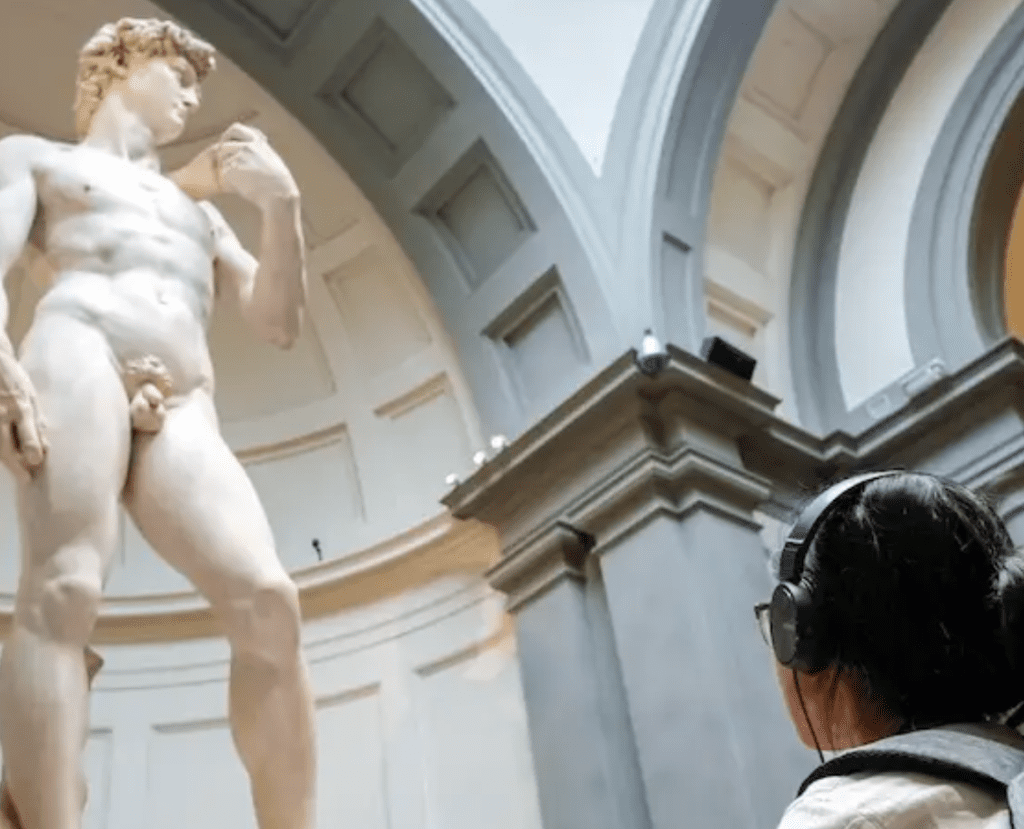
Looking for a tour of the Accademia Gallery while in Florence but you also want to save time and admire some of the others treasures of Florence?
On this small group tour, a professional art historian will spend the morning leading you through the world-renowned museum’s most breathtaking masterpieces.
Get up close to Michelangelo’s iconic David statue, see the artist’s most famous unfinished works, and marvel at historic paintings and sculptures by some of the world’s most prominent artists.
See tour itinerary, price, and description
Not ready to book a tour? Check out our Accademia and David Guide for more resources.
Places To Eat Nearby

If you’re visiting the Accademia around meal time, here are a few suggestions for good places to get something to eat. For more options, check out our article on the best restaurants near the Accademia. If you’re having a fancy meal, you may want to reserve a table otherwise, walk-ins are welcome in Florence.
Ristorante Cafaggi: €€ | Family Run—Looking for a great cut of meat or hearty meal? This is your place.
Fuoco Matto: €€ | Kid Friendly—Named “Crazy Fire,” this stylish restaurant has great pizza and high-quality meats and pasta dishes.
Arà: è Sicilia: € | Quick Food—Just want a snack? This Sicilian hole in the wall has incredible desserts and delicious supplì.
Ristorante Accademia: €€ | Tuscan Bistro—The name does scream “tourist trap,” but this place is off-the-charts buono!
Not ready to book a tour? See our best Florence tours to take and why.
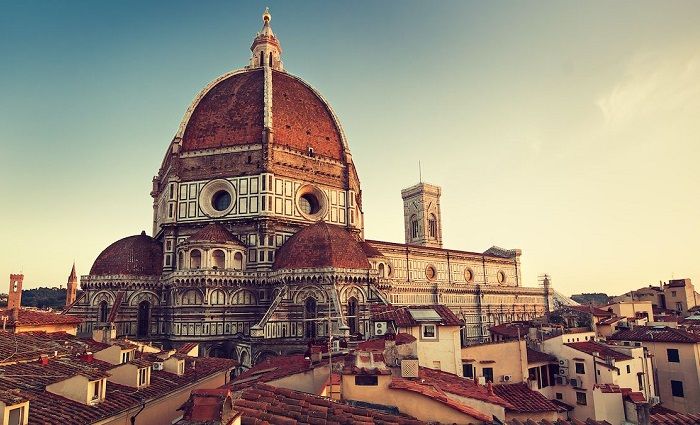
Where To Stay in Florence
Florence has a small historical center packed with iconic landmarks to explore. Plan where to stay in the best neighborhoods in this beautiful city.
